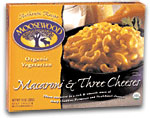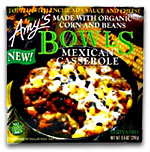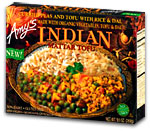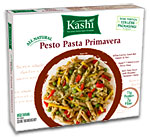
I have fond memories of microwaveable TV dinners from when I was a child: mac ‘n’ cheese, chicken nuggets, unidentifiable green lumps, mushy brown things. The wonder surrounding them was probably due to the fact that we weren’t usually allowed to eat them. Mama Shep is a great cook, and since we grew up on a vegetable farm, there were plenty of foods available that hadn’t been processed, frozen, and packaged months earlier. So TV dinners were a special treat.
Now that I’m responsible for feeding myself, I usually try to actually cook, in the tradition of Mama Shep. But, oh, how many times have I come home from work and, too lazy to make dinner, dined on random foods from the pantry rather than actually cooking — a carrot, a can of beets, some hummus, a hunk of cheese. “Wouldn’t it be nice to have something that at least resembles a home-cooked meal and covers multiple levels of the food pyramid?” I’ve often wondered. Those single-serving dinners began calling out to me from the frozen foods section of my local grocer. “Dine on me, Kate,” they said. “I’m so convenient.”
Grist’s Pick
Kashi Black Bean Mango
$4.49 (10 oz.)
I know they’re not particularly healthy, and all that packaging isn’t great for the planet. And they surely don’t taste as delicious as the boxes would lead me to believe. But, well … it’s so … easy. So in the interests of investigation, I volunteered to product-test some vegetarian, organic, and/or “natural” TV dinners. (I mentioned the task to another writer friend. “Thanks, you just totally blew the oxymoron circuit in my brain,” he said.)
Overall, the week’s worth of dinners I consumed was not as disgusting as I’d feared. Mostly they were just salty. There are even a few I would eat again, in a pinch, though I don’t think I’ll be making them my regular fare. Here are my utterly unscientific observations on a week’s worth of dinners, covering a range of pseudo-ethnic dishes, food groups, and caloric contents.

Moosewood Macaroni & Three Cheeses
Eco-claims: USDA organic, vegetarian, no genetically engineered ingredients
Nutrition info: Calories, 400; fat, 17 grams (26% Daily Value); saturated fat, 9 grams (45%); sodium, 670 mg (28%); protein, 17 grams
Cost: $2.99 (10 oz.)
I used to live in the town that houses the original Moosewood restaurant, and this doesn’t taste like anything I had there. But for something out of the microwave, it’s not terrible. Very creamy, and not gummy at all, which I feared from a frozen cheese product. I can almost convince myself that I actually taste the cheddar, parmesan, and neufchatel cheeses they promise on the box! The cheese sauce is a little runny, but the noodles are an appropriate level of softness. My chief criticism would be that it doesn’t involve any vegetables and isn’t even remotely healthy, and it’s also too salty.

Amy’s Bowls Mexican Casserole
Eco-claims: Made with organic corn and beans, no gluten, no GMOs, no bioengineered ingredients
Nutrition info: Calories, 470; fat, 16 grams (25% DV); saturated fat, 5 grams (27%); sodium, 780 mg (32%); protein, 11 grams
Cost: $4.69 (9.5 oz.)
This is supposed to be a casserole, with tamale as the base layer, some beans in the middle, and an enchilada sauce and cheese topping. The tamale is in rectangular chunks, though it’s squishy and unrecognizable. The enchilada sauce is good, though definitely mild, so don’t go expecting anything too spicy. The cheese, of the monterey jack variety, is convincing. If you set aside the idea that this is supposed to be a “Mexican” dish, it’s not all that unpleasant.

365 Organic Vegetable Lasagna
Eco-claims: USDA organic
Nutrition info: Calories, 360; fat, 13 grams (20% DV); saturated fat, 9 grams (45%); sodium, 1150 mg (48%); protein, 19 grams
Cost: $3.79 (10 oz.)
This was probably my least favorite of all the dinners. It’s not very flavorful — which, while better than tasting nasty, doesn’t make it good. The sauce is pasty, the noodles are squishy, and I couldn’t identify any real vegetables anywhere in there. It also has the highest sodium content of all the dinners I tried, almost half of what you’re supposed to eat in a day. My heart did not thank me for eating it. That said, the cheese is pretty good.

Kashi Black Bean Mango
Eco-claims: Vegan, all-natural
Nutrition info: Calories, 340; fat, 8 grams (12% DV); saturated fat, 1 gram (5%); sodium, 430 mg (18%); protein, 8 grams
Cost: $4.49 (10 oz.)
This one had the most appealing box, promising me “7 whole grains pilaf” and a “zesty mango sauce.” Inside, I find that the mango sauce is thick, pasty, and sticky — a total texture gross-out. But despite its strange consistency, it’s tasty. The rice and beans taste like actual rice and beans, and there are lots of identifiable veggies inside. It at least tastes the healthiest of all I’ve tried. Also, it’s somewhat spicy, with much more potent flavor than the others.

Amy’s Indian Mattar Tofu
Eco-claims: Non-dairy, gluten-free, no bioengineered ingredients
Nutrition info: Calories, 260; fat, 8 grams (12% DV); saturated fat, 1 gram (5%); sodium, 680 mg (28%); protein, 12 grams
Cost: $4.69 (9.5 oz.)
The rice has good texture, and the curried peas and tofu also generally replicated real food. The peas were crunchy and the tofu was firm. The dal, however, was a giant, mushy mass of baby-food-like quality. Indian food is one of my favorite genres, and to argue that this should be counted among it is probably blaspheme. All of the wonderful flavors in a good curry, and the only thing I really taste here is salt (sensing a trend?). The food left a ring of almost fluorescent yellow around the little paper dish, which makes me wonder.

Kashi Pesto Pasta Primavera
Eco-claims: Vegetarian, all natural, 11 percent less packaging!
Nutrition info: Calories, 290; fat, 11 grams (17% DV); saturated fat, 2 grams (19%); sodium, 750 mg (31%); protein, 11 grams
Cost: $4.49 (10 oz.)
This doesn’t taste bad, but it doesn’t taste like pesto, either. Pretty disappointing, considering that pesto is made primarily from herbs and spices and serves little purpose beyond flavoring. Mostly the sauce was just greasy and green. The peas, yellow carrots, and red peppers seem out of place seated atop the pesto, like they were thrown in to add some healthy, colorful flair — but they’re crunchy and they taste good. And the noodles are appropriately al dente.

Kahiki Naturals Teriyaki Mixed Vegetables
Eco-claims: No artificial additives, colors, or preservatives; minimally processed; no GMOs
Nutrition info: Calories, 240; fat, 1.5 grams (2% DV); saturated fat, 0 grams; sodium, 700 mg (29%); protein, 8 grams
Cost: $5.99 (9.5 oz.)
When I popped out the tray, the first thing I thought was, “What the hell are these giant, holey things that look like wheels?” The ingredients list revealed that they were lotus root, “an authentic Chinese vegetable with a subtle flavor and crunchy texture.” Since they were giant, they remained frozen while the rest of the dish got extremely hot. In the interest of not nuking the taste out of the rest, I just ate the lotus frozen, which probably didn’t help the dish much. It tasted fine enough, as teriyaki flavor is hard to screw up. Like the others, it was too salty — but healthier, according to the metrics on the box. This one didn’t seem like it contained as much food as the others, however, so I was still hungry afterward and started snacking almost immediately.
The bottom line: If you’re eating stuff that comes out of a box and is “ready to serve” in 3.5 minutes, it’s probably not Top Chef quality, even if it’s “organic” or “natural” or whatever else you want to call it. However, if you’re in a hurry and want something meal-like, these aren’t as terrible as you might imagine. The biggest turn-off is really the salt factor, so look for low-sodium versions. And with all of them, supplementing with a salad or other real, recently living vegetation is a must.

